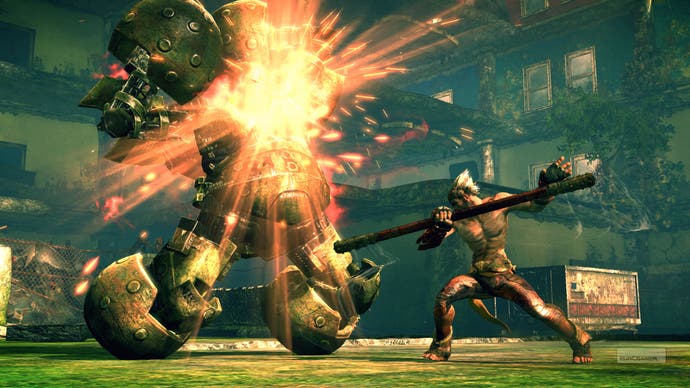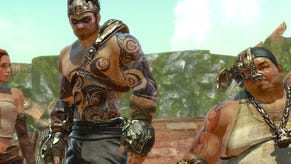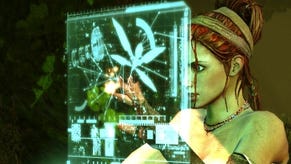Enslaved: Odyssey to the West
Monkey brawl.
Quite. So it's the future rather than the mythic past, and it's New York City and the Eastern Seaboard rather than a fantastical Asia of rope bridges and unlikely rock formations. Enslaved casts you as Monkey, a wild man survivalist and loner, who's unfortunate enough to find himself captured by one of the slave ships that scours the wastelands of this future earth, plucking up stragglers for nefarious - yet largely unknown - purposes.
Even more unfortunately for him, he makes a frantic escape with a fellow prisoner named Trip. Trip is, frankly, a bit Goat's Cheese, a flower child from a nearby eco community and a lady who's philosophically keenly opposed to Monkey's go-it-alone approach. She believes in collectivism, in rebuilding the world one society at a time, and she probably believes in Dreamcatchers and mood rings, too.
She also wants to get home pretty sharpish, however, and, crash-landing deep in New York, with the world still riddled with those ancient hunter-killer robots, she knows she won't be able to do that alone. Instead, she fits Monkey with a headband that, rather charmingly, will explode if he doesn't do her bidding, and forces him to take her back to her people.
It's not, as you might have gathered, the friendliest of alliances. Antoniades, with a gift for understatement, describes the relationship as "quite tense", and while the emphatically single-player campaign might call to mind the likes of ICO as Monkey helps Trip across tumbledown ledges and around precarious finials and rooftops, if you look at the details you can see a very different story being told.

Monkey's in-game animations betray real hostility. When he throws Trip across a gap between fire escapes, there's very little love in the gesture, and when he carries her on his back whenever they need to move at speed, he makes sure she jounces uncomfortably against him.
It suggests a very promising mechanic, as the game is a three-way split between acrobatic traversal, combat and good old spatial reasoning. Thrown into a section fairly early in proceedings - in amidst the toppled brownstones and creaking water towers of New York - it's immediately clear that, as with Splinter Cell: Conviction, if you squint a bit this is essentially an elaborate puzzle title disguised as action.
While the game flows between set-pieces much more organically than Heavenly Sword ever did, planning ahead is an essential part of the Enslaved's rhythm. One of Trip's gadgets is a Dragonfly - a kind of hovering CCTV camera that she's reprogrammed to allow the duo to scout out the next few city blocks - and your best course of action when moving to a new area is almost always to send it out, and get a sense of the landscape.
The Dragonfly highlights your eventual objective, tagging the doorway or alcove that will take you onto the next section, and alerts you to any drone enemies that lie in your path. Crucially, it fills you in on each robot's activation zone, pointing out the spots on the map that you really shouldn't step into if you want to escape alive.
While it's rare that you'll ever be able to actually avoid combat, the real task of the game is to approach it from the best position. Monkey's strong, but he'll rarely be able to take on more than two Scouts at any one time, and he's absolutely useless against anything with a cannon attached.
Instead, you have to use cover to get as close to your targets as possible, ending fights almost before they've begun, reaching turrets before they've sprung to life, and ripping off their gun arms to use against more powerful foes, clearing any grunts out of the way before something truly mammoth comes at you.







